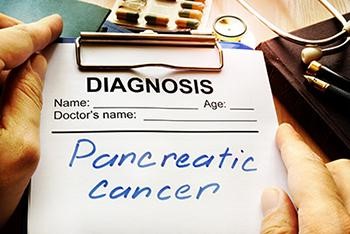
Dr. Robert Martin , pancreatic cancer expert with UofL Physicians – Surgical Oncology and UofL Brown Cancer Center, answers our questions.
With the news about Alex Trebek’s pancreatic cancer diagnosis, he said the outlook is not encouraging. What’s the survival rate for a diagnosis like this?
There are 55,000 new cases of pancreatic cancer in U.S. each year. The problem is there are probably 44,500 deaths in that same year. Pancreatic cancer has the lowest survival rate of any major cancer type because of environmental factors coinciding with genetic factors. It’s the second leading cause of cancer death after lung cancer.
What puts someone at higher risk for pancreatic cancer?
Environmental factors that increase risk for pancreatic cancer are obesity, tobacco use, chronic stomach problems and diabetes.
The good news is that most environmental risk factors are correctable and reversible with a change in lifestyle.
There are some genetic syndromes that can put you at higher risk.
What stage is pancreatic cancer typically diagnosed?
More than 80 percent of those diagnosed with pancreatic cancer will be diagnosed late stage. Half of those will be stage 3, locally advanced, and half will be stage 4, metastatic cancer that has spread beyond the pancreas.
What contributes to the later stage diagnosis?
Pancreatic cancer doesn’t have a high-risk factor group. While five percent may have a genetic syndrome putting them at higher risk, 95 percent of patients do not have a defined age range, racial or social demographic, or location risk factor.
We also don’t have an inexpensive way to screen for pancreatic cancer like we do for other types of cancers.
One area of optimism that UofL published about five years ago was the concept of newly-diagnosed diabetes (type 2) after 45-50 years of age. It’s becoming a new widely-accepted risk factor that if you’re newly-diagnosed with diabetes after this age that you are at higher risk for pancreatic cancer later in life, usually between two to 10 years later.
What signs/symptoms should someone look out for?
Symptoms will vary depending on the location of the tumor. If it’s on the right side in the pancreatic head, you’ll have jaundice (yellowing of the skin). If it’s in the pancreatic body or tail, there’s commonly a deep, abdominal pain that radiates to the back. It’s often misinterpreted as back pain. Also feeling full faster and losing weight when you’re not trying to.
Many people are trying to lose weight, but if you only started walking a little bit and you’re shedding the pounds, then that’s not normal.
If someone is having these issues, we need to look at their overall lifestyle. You should have an honest conversation with your primary care provider and weigh these factors to determine if imaging is necessary.
What treatment options are out there?
At UofL we have achieved significant improvement in pancreatic cancer treatment. Trebek’s first step will likely be systemic chemotherapy for three to four months, which produces a 30-35 percent response rate. Based on external review, he appears to be vibrant and healthy so he should be able to receive this treatment. Then based on the extent of metastatic disease, he could be open to additional treatment options.
UofL pioneered the use of irreversible electroporation (IRE) for treatment of stage 3 pancreatic cancer, when it’s local and has not spread. Ten years ago the survival rates for stage 3 and 4 were the exact same. There wasn’t a treatment that could truly eradicate the disease. We optimized the use of high voltage electrical pulses to kill cancer cells without damaging other areas and we’ve seen patients have success and be cancer-free for several years now.
Because of the way this works, it actually stimulates the immune system to make the cancer seem foreign. We’re now looking at the role of this with immunotherapy drugs to see if we can take a “silent” tumor and make it an “immunologically hot” tumor so that immunotherapy drugs can be effective.









